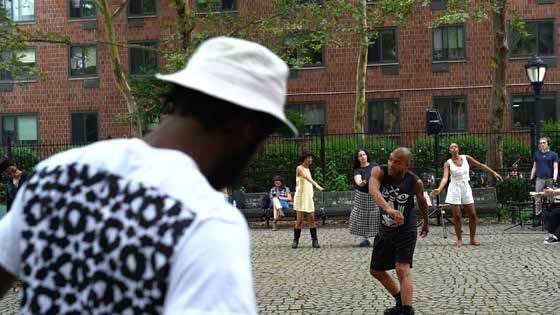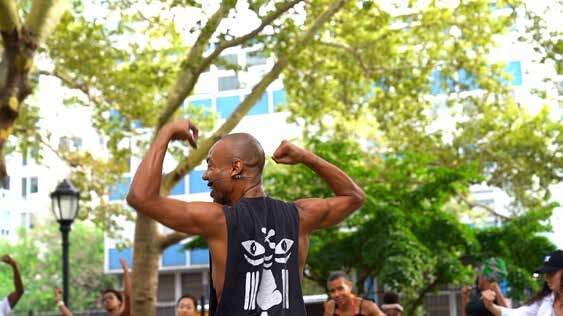Artists on Artists: sonia louise davis, David L. Johnson, and Shamel Pitts on Smokehouse Associates
Smokehouse Associates was a collective active in Harlem from 1968 through 1970. Imagined by artist William T. Williams in 1968, the Smokehouse Associates created public art projects in Central and East Harlem. The collective included four members: Williams, Melvin Edwards, Guy Ciarcia, and Billy Rose—but really included the entire community. Smokehouse believed that if you changed your environment, and somehow made it more beautiful, then that in and of itself could be transformative.
In what is now Harlem Art Park, in the summer of 1968, Smokehouse reinvigorated a space that had once been forgotten, transforming its walls with geometric forms and colors, with residual traces you can still spot today.
This was the third public program in a series that celebrated the Museum’s 2022 Smokehouse Associates publication, edited by Eric Booker. In entering and sharing space together, we became a part of an expanded history, each of us becoming another vessel of a shared memory, experience, and existence.
sonia louise davis led a “tuning” breath exercise before reading an original text in homage to “Wellspring, Opus 341” from Harlem-born singer Jeanne Lee’s 1979 album Oasis, a duet with multi-instrumentalist Gunter Hampel. The track references local landmarks (all since shuttered) from the perspective of a flâneur “strollin’ down Seventh Avenue.”
Shamel Pitts led a Gaga/people session, a movement class charged with rich, descriptive imagery that stimulates imagination, activates the body and physical sensations, and encourages awareness of one’s thoughts and surroundings.
David L. Johnson reflected on communal access and stewardship of public space through a performative lecture that engaged with the structure of Harlem Art Park’s public hours and the Smokehouse Associates’ relationship to Harlem Art Park.
Included on these pages are excerpts and images from this incredible event.
—Habiba Hopson and Daonne Huff
Excerpt from sonia louise davis, “jeanne and me”
J-E-A-N-N-E
end of january aquarius like me
spelled the same as my grandmother’s name
boundless blossoming beautiful
jeanne lee.
… she said, “i look at myself as already an environment,
the environment is there and it comes through me in sound.
in turn the music is created as a total environment to the audience.
i’m always trying to allow the environment to manifest itself through me…
when i’m working with a musician i’m trying to deal with the sound.
when i want to direct the music i create a poem
and then there’s a more deliberate environmental frame and we all work within that.”
how incredible to call oneself an environment, how brave, how brash.how truly expansive.to be so fully immersed in the sound, to push at the edge of language, and beyondto be such an active listening being,we could all strive for something like this.a networked ecosystem, without strict borders, instead with shifting edges and permeability,exploring the soft lines between us.trees are known to communicate via underground fungal pathways,and send signals to kin far afield,alerting of dangers immanent or ongoing.trees unexposed to an attack may still unleash antibodies as precaution.this sounds to me a little like a version of, we keep us safe.
i love how she talks about what she does, how it precedes a radicalism
that now seems everyday but also points to a version of utopian equity
still so far from reach. the fullness of her voice, meeting the corollary of
the fullness of her entire multifaceted being, is ambitious in any of the
art worlds one might find herself conjugated in. porter begins his article
by saying that the scope of her work was inaudible to many scholars.
i wonder what, if any, radical potential there is in being un-listenable
(rather than un-listened-to or ignored). what if her sound is so different,
so difficult, so unlike what we are used to hearing and how, that we
can’t place her and therefore she has succeeded in exploding our very
definitions and categories altogether? i try in my work to trouble hierarchies
and expectations, because generally, i have found that whatever
anyone else might expect of you is probably so much less beautiful and
challenging and utterly spectacular than what you’re actually capable of.
… a wellspring is a source, an origin pointi can’t help but see these lyrics as something of a homecoming(she performed more often in europe,the album “oasis” was recorded in rome)in this neighborhood jauntshe’s wayfinding, letting us in on her casual walking route,a fl.neuse with a(suddenly) sunny sunday afternooni love the pace of it — strollin’the walk is the point, she’s in no rush to get anywhere specific,(the rain has come and gone)and yet she’s invested in the infinitely inspirational local context.jeanne is my wellspring, moving effortlessly between poles,showing us how not opposed they could be,lighting the way towards what might be if we try.the alternate reality we make by improvising,exploding the limits that crush possibility and difference,it can be a softer, more porous, and spacious spacegenerative, nuanced, complicated, messy.
David L. Johnson Art Park Walking Tour


DAVID L. JOHNS, SMOKEHOUSE REMNANT, 2023. COURTESY THE ARTIST
Between 1968 and 1970, the Smokehouse Associates produced nine mural projects across East Harlem. These murals were installed on the walls of local businesses, empty lots, and public parks. The collective employed geometric abstraction to intervene in the aesthetic and structural conditions of the city. Working collaboratively with community members who lived and worked on these blocks, the murals became active components of neighborhood life. In many cases, these projects brought resurgent forms of sociality to areas that had previously been disinvested by the city. Many of these murals endured for decades under the care of old and new collaborators, while others transformed into entirely new forms of iconography through paint overs.
Today, almost all visual remnants of Smokehouse’s murals have faded from public view. As the city has continued to change, many of the walls and buildings that once hosted Smokehouse’s work have been demolished. Some of these sites have transformed and persisted as active community spaces, such as the La Casa Del Alfarero Church and Dr. Ronald E. McNair Playground, while others have given way to new condo developments. However, in one park on Sylvan Place, some fragments of Smokehouse’s original imagery can still be found.
Let the message be the change.
In 1968, the Smokehouse Associates created two murals in a small pocket park, known today as Harlem Art Park. These murals were made as part of a revitalization effort after the park had fallen into disuse. Previously known as Sylvan Park, the space had functioned as an unfenced leisure area since 1938. By the 1960s, the city had ceased maintenance operations in the park, even removing bench planks to discourage people from sitting and sleeping. Smokehouse’s colorful murals became the primary catalyst for reclaiming the park as a public space. After a major renovation in 1985 by landscape architect Lee Weintraub, the park doubled in size. Under the stewardship of the neighborhood organization Friends of Art Park Alliance, founded by Debbie Quinones in 2015, the park has continued to serve as a site for community and cultural events.
On the north wall of the park, faint streaks of color can still be discerned underneath a layer of peeling gray paint. This wall belongs to the Harlem Community Justice Center, a small claims court. Originally constructed in 1893, the building was initially known as the Harlem Courthouse. The courthouse served as a county seat for New York City until 1961, after which it temporarily closed. However, the building had an alternative identity—the Harlem Prison, where it stands today as the oldest extant jail structure in New York City. In the basement of the courthouse, forty decommissioned cells still remain, once used to hold individuals awaiting sentencing. Before becoming a park, the lot property of Harlem Art Park was utilized as the prison’s recreational yard.
Often existing in the shadow of histories of dispossession and active policing, the work of individuals and collectives to sustain accessible public spaces is an ongoing process, just as in Smokehouse’s ethos of “Let the message be the change.”
Shamel Pitts on Gaga Movement
One of the things I love about teaching/sharing Gaga movement language with others is the communal practice and power of dancing together. This practice of coming together to dance, to move, to communicate through the body is primordial, uplifting, and everlasting.
Gaga allows me the space to listen to my body before telling it what to do and then respond with coherence. The practice of listening and activating what is inside of us, between us, and around us ignites a higher level of awareness and response-ability as a responsibility.
What a pleasure it is to participate in the Studio Museum’s Artists on Artists program to continue the work of Harlem’s Smokehouse Associates by offering m o v e m e n t—as a public art service to communities—which by definition is transformation.


STILLS FROM SHAMEL PITTS’S GAGA/PEOPLE CLASS, 2023. COURTESY SEN.FLOYD


STILLS FROM SHAMEL PITTS’S GAGA/PEOPLE CLASS, 2023. COURTESY SEN.FLOYD

